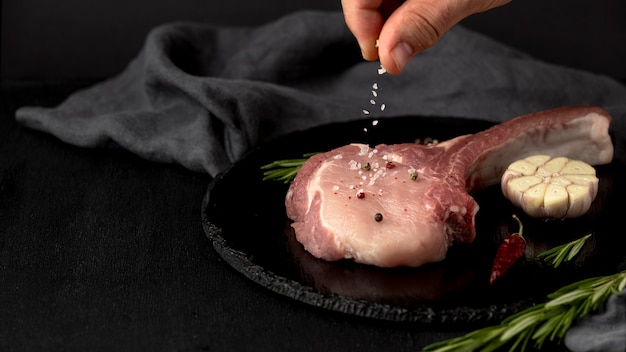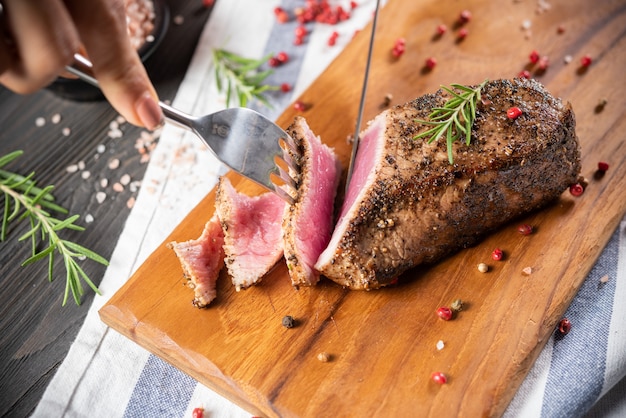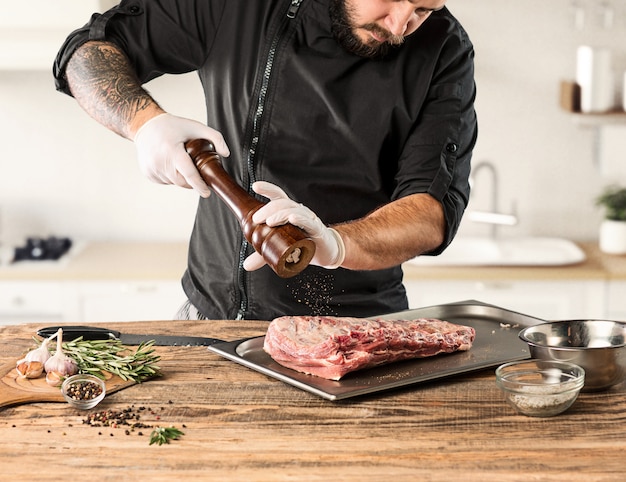Let's be honest, there's something undeniably alluring about filet mignon. It's the king of steaks, a succulent, tender cut of beef that conjures images of elegant dinners and luxurious meals. But, let's face it, cooking it can be a bit daunting. You don't want to mess up that beautiful piece of meat, right? You want a perfectly seared exterior, a juicy, pink interior, and a symphony of flavors that dances on your palate.
Well, fear not, my culinary adventurer! I've been on a personal quest to conquer the art of cooking filet mignon, and I've learned a few tricks along the way, some of them the hard way (don't ask about my first attempt!). But, the journey has been worth it, and today, I'm sharing all my secrets with you. So, grab a pen, a notepad, and a glass of something delicious, and let's delve into this masterclass together.
(Part 1) Understanding the Beast: A Closer Look at Filet Mignon

From the Cow's Back to Your Plate: The Tale of Tenderloin
Before we jump into the cooking process, let's take a moment to appreciate our star ingredient. Filet mignon, also known as tenderloin, comes from the long, thin muscle that runs along the cow's backbone. This muscle is barely used by the animal, making it remarkably tender and incredibly flavorful. It's essentially the VIP section of the beef world, a true delicacy!
Grades and Marbling: Unveiling the Secrets of Flavor
Now, you'll often see terms like "Prime" and "Choice" associated with filet mignon. These terms refer to the quality grade of the beef, which is a measure of its marbling, those beautiful streaks of fat that add richness and flavor. Prime is the highest grade, boasting the most marbling, resulting in a juicy, flavorful steak. Choice is a step down, still a quality cut, but it might be slightly leaner.
Personally, I'm a huge fan of prime filet mignon. That extra marbling adds a luxurious richness and buttery texture that I find irresistible. But, hey, everyone has their own taste preferences, so choose what speaks to your palate!
(Part 2) Preparing for the Showdown: The Essential Tools

Let's talk about the tools that will make this culinary adventure a success. You don't need a fancy chef's arsenal, but there are a few essentials that will make a world of difference.
The cast iron pan: Your Culinary Hero
A good cast iron pan is your best friend for cooking filet mignon. It's a true workhorse in the kitchen, distributing heat evenly for that perfect sear. Plus, it gets incredibly hot, which is crucial for creating that crispy, golden crust without overcooking the inside.
I have a vintage cast iron pan that my grandmother passed down to me, and it's become a family heirloom. It's seen generations of delicious meals, and it's a true testament to the durability and versatility of this cookware.
A meat thermometer: Your Reliable Guide
I know, I know, it might seem a bit technical, but trust me, a meat thermometer is your culinary compass. It's the only way to guarantee your filet mignon is cooked to your exact preference, no matter the method you choose. Remember, cooking a steak is like walking a tightrope - you want that perfect balance between a juicy interior and a delightful sear. A meat thermometer helps you avoid any culinary mishaps!
A Sharp Knife: The Key to Precision
You'll need a sharp knife to trim any excess fat or silver skin from the filet mignon. This might seem like a small detail, but it's essential for even cooking and a beautiful presentation. A good knife is a chef's best friend, and it makes all the difference in the world.
(Part 3) The Art of Seasoning: Mastering the Flavor Profile

Now, let's get into the fun part - flavor! Seasoning your filet mignon is like adding the final brushstrokes to a masterpiece. You want to enhance its natural flavors, not overwhelm them with a barrage of spices. It's all about balance and elegance.
Keeping it Simple: Salt and Pepper
I'm a firm believer in the "less is more" approach when it comes to seasoning filet mignon. Salt and pepper are all you really need. They bring out the natural sweetness and umami of the beef, and they create a delicious, crispy crust that's both satisfying and flavorful. I use kosher salt, as it's coarser and dissolves more evenly, and freshly ground black pepper for that extra kick.
A Touch of Sophistication: Herbs and Spices
If you're feeling adventurous, you can experiment with a few herbs or spices to add a touch of complexity. I love the earthy aroma of rosemary, the delicate flavor of thyme, or the pungent kick of garlic. Just a sprinkle is all you need to create another dimension of flavor. Remember, the key is to complement, not overpower, the natural taste of the steak.
The Secret Weapon: Garlic Butter
For an extra layer of indulgence, consider rubbing some garlic butter onto your filet mignon before cooking. The garlic adds a subtle, savory note, while the butter contributes richness and moisture. But, be mindful, a little goes a long way! You don't want to overwhelm the delicate flavor of the meat.
(Part 4) Mastering the Cooking Methods: From Pan-Seared to Oven-Roasted
Now, let's get into the heart of the matter - the cooking methods. There are several ways to cook filet mignon, each with its own advantages and nuances. Let's explore some of the most popular options.
The Classic: Pan-Searing
This is the most common and widely beloved method for a reason. It's quick, easy, and yields a beautifully seared exterior with a juicy, tender interior. Here's the breakdown:
- Heat your cast iron pan over medium-high heat. The pan should be hot enough to sizzle when you add a drop of water.
- Generously season your filet mignon with salt and pepper. Don't be shy with the seasoning, it's your chance to create a delicious crust!
- Add a tablespoon of oil to the pan. I prefer to use a neutral oil with a high smoke point like avocado oil or grapeseed oil.
- Sear the filet mignon for 2-3 minutes per side, or until you achieve a nice golden brown crust. You want to hear that satisfying sizzle as the meat hits the pan.
- Reduce heat to medium-low and continue cooking for another 2-3 minutes, or until the filet reaches your desired doneness. This is where your meat thermometer comes in handy!
- Remove from heat and let the filet mignon rest for 5-10 minutes before slicing. This allows the juices to redistribute throughout the meat, ensuring a tender, flavorful result.
The Versatile: Oven-Roasting
Oven-roasting is a great option if you're cooking multiple filets or if you prefer a more even cooking method. It's a bit more hands-off than pan-searing but delivers equally delicious results. Here's the process:
- Preheat your oven to 400 degrees F (200 degrees C). Let the oven heat up thoroughly for consistent heat distribution.
- Season your filet mignon generously with salt and pepper. Don't forget the sides!
- Place the filet mignon in a roasting pan. You can add a few tablespoons of water to the bottom of the pan for added moisture.
- Roast for 10-15 minutes, or until the internal temperature reaches your desired doneness. Use your trusty meat thermometer to check the progress.
- Remove from oven and let rest for 5-10 minutes before slicing. This is crucial to retain that juicy tenderness.
The Indulgent: Sous Vide
If you're looking for the ultimate in precision and control, then sous vide cooking is the way to go. This method involves cooking the filet mignon in a water bath at a precise temperature, ensuring that it's cooked evenly throughout. It's a bit more involved but delivers exceptional results, especially for those who love their steaks cooked to perfection. Here's the gist of it:
- Season your filet mignon generously with salt and pepper. Don't forget to season all sides!
- Vacuum seal the filet mignon in a food-safe bag. You can use a vacuum sealer or a Ziploc bag and the water displacement method.
- Immerse the bag in a water bath set to the desired doneness temperature. Make sure the water bath is large enough to fully submerge the bag.
- Cook for at least 1-2 hours, or until the internal temperature reaches your desired doneness. This method allows for a longer cooking time, resulting in a more tender and flavorful steak.
- Remove from water bath and pat dry. You can then sear the filet mignon for a few minutes per side in a hot pan to achieve that beautiful, crispy crust. This adds a finishing touch and enhances the flavor.
(Part 5) The Doneness Debate: Finding Your Perfect Level
Now, here's where things get a bit personal. Everyone has their own preferred level of doneness for filet mignon, from a juicy, rare center to a well-done steak. But remember, there's no right or wrong answer. It's all about finding what you enjoy most.
| Doneness Level | Internal Temperature | Description |
|---|---|---|
| Rare | 125-130 degrees F (52-54 degrees C) | Center is very red, cool to the touch, and slightly firm |
| Medium Rare | 130-135 degrees F (54-57 degrees C) | Center is slightly red, warm to the touch, and slightly firm |
| Medium | 140-145 degrees F (60-63 degrees C) | Center is pink, warm to the touch, and slightly firm |
| Medium Well | 150-155 degrees F (65-68 degrees C) | Center is light pink, warm to the touch, and firm |
| Well Done | 160 degrees F (71 degrees C) and above | Center is brown, hot to the touch, and firm |
Remember, this is just a guideline. The thickness of your filet mignon and the cooking time can affect the internal temperature, so always use a meat thermometer to double-check.
(Part 6) Resting: The Art of Patience
After all that effort, it's tempting to dive into that beautifully cooked filet mignon right away. But hold your horses! Resting is an essential step that often gets overlooked. It allows the juices to redistribute throughout the meat, ensuring a juicy, tender, and flavorful steak. Let your filet mignon rest for at least 5-10 minutes before slicing and serving. It's a small step, but it makes a big difference in the final outcome.
(Part 7) The Finishing Touches: Elevating Your Creation
Your filet mignon is cooked to perfection, it's rested, and you're ready to enjoy the fruits of your labor. But hold on, there's still room for some finishing touches that will take your dish from delicious to extraordinary. It's all about enhancing those flavors and creating a symphony of tastes.
A Burst of Flavor: Sauces and Toppings
Adding a sauce or topping is a fantastic way to complement the rich flavor of filet mignon. Here are a few classic and creative options:
- Béarnaise Sauce: Classic and creamy, with a hint of tarragon and lemon. It's a perfect balance of tangy and savory, adding a touch of sophistication to the dish.
- Red Wine Sauce: Rich and full-bodied, with a hint of sweetness and acidity. It's a great way to enhance the earthy flavors of the steak and create a luxurious taste experience.
- Mushroom Sauce: Earthy and savory, with a velvety texture. It's a classic pairing for steak, adding a depth of flavor and a touch of decadence.
- Peppercorn Sauce: Spicy and bold, with a kick of black pepper. It adds a punch of heat and complexity to the dish, perfect for those who enjoy a bit of spice.
You can also get creative with your toppings. Try a dollop of horseradish cream for a spicy kick, a sprinkle of fresh herbs for a touch of freshness, or even a few crispy onion rings for a contrasting texture.
The Sidekick: Finding the Perfect Pairing
No steak is complete without a perfect side dish. Here are a few classics that complement the rich flavor of filet mignon:
- mashed potatoes: Creamy, comforting, and the ultimate classic side dish for steak. It's the perfect balance of simplicity and elegance.
- Roasted Vegetables: Bring out the natural sweetness of the vegetables with a touch of honey or balsamic vinegar. It adds a touch of brightness and contrast to the rich steak.
- Asparagus: A light and refreshing side that complements the rich flavor of steak. Its delicate flavor and slightly bitter notes provide a refreshing counterpoint.
- Creamed Spinach: A decadent and creamy side that's both comforting and sophisticated. It's a luxurious addition to the meal, adding a touch of richness and elegance.
(Part 8) FAQs: The Big Questions Answered
1. What's the Best Way to Store Filet Mignon?
To keep your filet mignon fresh, store it in the refrigerator for up to 3 days. Wrap it tightly in plastic wrap or place it in an airtight container. For longer storage, you can freeze it for up to 3 months. Just make sure to thaw it in the refrigerator overnight before cooking. Never thaw it at room temperature, as this can lead to bacterial growth.
2. Can I Cook Filet Mignon Frozen?
It's not recommended to cook filet mignon frozen. It'll cook unevenly, resulting in a tough and dry piece of meat. Always thaw your filet mignon completely in the refrigerator before cooking.
3. How Can I Tell If Filet Mignon is Cooked to My Desired Doneness?
The best way to determine doneness is by using a meat thermometer. Insert it into the thickest part of the filet mignon and check the internal temperature against the chart provided above. You can also use the "touch test" to estimate doneness. Press the filet mignon gently with your finger. If it feels soft and springy, it's rare. If it feels firmer, it's medium-rare. And if it feels firm and bouncy, it's well done. But remember, the meat thermometer is your most reliable guide.
4. What If My Filet Mignon is Overcooked?
Don't despair if your filet mignon is slightly overcooked! It's not the end of the world. You can try slicing it thinly and serving it with a sauce that will add moisture and flavor. Or, if you're feeling adventurous, you can try turning it into a steak salad or a delicious hash. Remember, a little creativity can go a long way!
5. What's the Best Wine Pairing for Filet Mignon?
A good red wine like Cabernet Sauvignon, Merlot, or Syrah pairs beautifully with filet mignon. The tannins in the wine complement the rich flavor of the meat, while the acidity helps to cut through the richness. You can also try a lighter-bodied red like Pinot Noir or a crisp white wine like Sauvignon Blanc. Ultimately, the best wine pairing comes down to personal preference. Experiment and find what you enjoy most!
(Part 9) The Final Word: Elevate Your Culinary Game
There you have it! You're now equipped with the knowledge and techniques to cook the perfect filet mignon, no matter your skill level. So, grab that beautiful piece of meat, gather your tools, and get ready to impress your friends and family with a culinary masterpiece.
Remember, the key to success is practice, patience, and a willingness to experiment. Don't be afraid to try different seasonings, cooking methods, and pairings. You might just discover your new favourite way to cook filet mignon. Happy cooking, and bon appétit!
Everyone is watching

Corn on the Cob: The Ultimate Guide to Perfectly Cooked Ears
Healthy MealsAh, corn on the cob. Just the name evokes images of sunny days, barbecues, and that sweet, juicy flavour that ...

Perfect Pork Roast Oven Cooking Time: A Guide to Delicious Results
Healthy MealsThere's something truly satisfying about a perfectly roasted pork. The aroma alone is enough to make your mout...

Ham Cooking Time: How Long to Bake, Smoke, or Boil a Delicious Ham
Healthy MealsAh, ham. It's a classic, isn't it? A real crowd-pleaser, especially around holidays. And when done right, it'...

Scallops: The Ultimate Guide to Perfect Cooking
Healthy MealsAh, scallops. Those delicate, sweet, and utterly delicious morsels of the sea. They hold a special place in my...

Spaghetti Squash: The Ultimate Guide to Cooking and Serving
Healthy MealsRemember that time you saw spaghetti squash at the supermarket, looking all bumpy and strange, and thought, "W...
